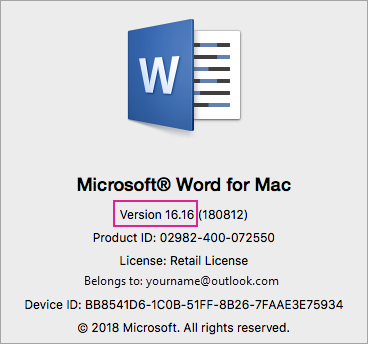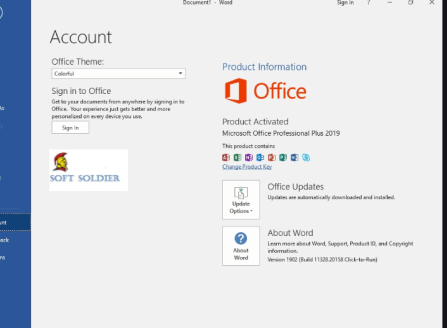- Microsoft Office 2019 For Mac 16.17 Vlc
- Microsoft Office 2019 For Mac 16.17 Vlog
- Microsoft Office 2019 For Mac 16.17 Vlookup
- Microsoft Office 2019 For Mac 16.17 Vlc Media Player
Upgrade to Office 2019 for Mac: If you're a volume licensed customer, you can upgrade to Office 2019 for Mac without uninstalling Office 2016 for Mac. First, you need to download the 2019 version of the Volume License (VL) Serializer from the Volume Licensing Service Center (VLSC). Second, download the latest version of Office 2019 for Mac. Applies to: Office 2019 for Mac. The Volume Serializer (VL) is used to activate Office 2019 for Mac as a volume licensed version. It's an approximately 4 mb package file that you run on a user's computer, either before or after you've installed Office. Download the Volume License (VL) Serializer from the VLSC. This tool allows an easy and comfortable way to download genuine Windows 7, Windows 8.1 and Windows 10 disk images (ISO) directly from Microsoft's servers, as well as Office 2010, Office 2013, Office 2016, Office 2019, Expression Studio and Office for Mac. 17:46 - apple2000 mentioned Ment in post Microsoft Outlook 2019 for Mac v16.37 VL Multilingual.ets you share attachments right from OneDrive.
Applies to:Office for Mac, Office 2019 for Mac
There are two basic ways that you, as an admin, can deploy Office for Mac to users in your organization:
Provide your users with the installer package file, and have them install Office for Mac for themselves
Download the installer package file to your local network, and then use your software distribution tools to deploy Office for Mac to your users
If you have an Office 365 (or Microsoft 365) plan, you can provide your users with instructions on how to download and install Office for Mac for themselves. To install Office for Mac, a user has to be administrator on the Mac or know an administrator account name and password.

But, if you deploy Office for Mac for your users, you have more control over the deployment, including which users get Office for Mac and when. To plan your deployment, review the following information.
Download Office for Mac to your local network
The easiest way to download Office for Mac, and ensure you're always getting the most current version and build, is to download directly from the Office Content Delivery Network (CDN) on the internet. Here are the links to the installer packages for the Office suite, which contains all the applications:
- Office for Mac (for Office 365 or Microsoft 365 plans)
- Office 2019 for Mac (for retail or volume licensed versions)
Important
Support for Office 2016 for Mac ended on October 13, 2020. For more information, see End of support for Office 2016 for Mac.
Here is some additional information about installer packages:
- Installer and update packages for individual applications are also available on the Office CDN. For links to those packages, see Most current packages for Office for Mac.
- The same installer package is used for Office for Mac and Office 2019 for Mac. How you activate the product determines whether you get the features for Office for Mac or the features for Office 2019 for Mac.
- Unlike Office 2016 for Mac, the installer package for Office 2019 for Mac isn't available on the Volume Licensing Service Center (VLSC).
Deploy Office for Mac to users in your organization
Office for Mac uses the Apple Installer technology for installation. That means you can use the software distribution tools that you normally use to deploy software to Mac users. Some of the most common tools are Jamf Pro, Munki, and AutoPkg. You can also use Apple Remote Desktop and AppleScript.
Important
There are changes in Office for Mac to improve security, including implementing Apple app sandboxing guidelines. These changes mean that you can't customize the app bundle before or after you deploy Office. Don't add, change, or remove files in an app bundle. For example, even if you don't need the French language resource files for Excel, don't delete them. This change prevents Excel from starting. Even though you can't customize app bundles, you can configure preferences for each app.
Additional deployment information for Office for Mac
Whichever deployment method you decide to use, the following information can help you plan your Office for Mac deployment.
What's new: Before you deploy, review the information about what's new for admins in Office for Mac. This article includes information about system requirements, language support, and new features.
Side-by-side installation: You can't have Office 2016 for Mac, which is no longer supported, and Office 2019 for Mac installed on the same computer. Also, you can't have Office for Mac (from an Office 365 or Microsoft 365 plan) along with either Office 2016 for Mac or Office 2019 for Mac (both of which are one-time purchase versions) installed on the same computer.
Deploying individual apps: Installer package files for individual applications are available on the Office Content Delivery Network (CDN). For links to those files, see Most current packages for Office for Mac.
Activation: To use Office for Mac, it needs to be activated. Before you deploy, review the information about how activation works in Office for Mac.
Uninstalling: If you need to uninstall Office for Mac, you can follow these steps to completely remove Office for Mac. Unfortunately, there is no program to uninstall Office for Mac automatically.
Version numbers Version numbers of 16.17 or higher for retail or volume licensed installs indicate you have Office 2019 for Mac. Office 2016 for Mac, which is no longer supported, had version numbers of 16.16 or lower. Since the 'major' version (16) hasn't changed between Office 2016 for Mac and Office 2019 for Mac, application settings, including policies, preferences, and preference domains are similar between the two versions. Also, add-ins and other extensibility solutions that were compatible with Office 2016 for Mac will most likely be compatible with Office 2019 for Mac or will require minimal testing.
Upgrade to Office for Mac or to Office 2019 for Mac

Upgrade to Office for Mac (subscription version): If you're a volume licensed customer of Office 2016 for Mac or Office 2019 for Mac, you can upgrade to Office for Mac (available with certain Office 365 or Microsoft 365 plans) without uninstalling your current version. First, download and run the license removal tool. Second, launch Microsoft AutoUpdate (MAU) and install the latest Office updates. Finally, launch any Office app and sign in with your Office 365 or Microsoft 365 account. For a demo of these steps, and an example of how to automate this process with Jamf Pro, watch this video.
Upgrade to Office 2019 for Mac: If you're a volume licensed customer, you can upgrade to Office 2019 for Mac without uninstalling Office 2016 for Mac. First, you need to download the 2019 version of the Volume License (VL) Serializer from the Volume Licensing Service Center (VLSC). Second, download the latest version of Office 2019 for Mac. Then, deploy both the Volume License (VL) Serializer and Office 2019 for Mac to each device running Office 2016 for Mac. There is no need to remove Office 2016 for Mac first.
Related articles
-->
Applies to:Office 2019 for Mac
The Volume Serializer (VL) is used to activate Office 2019 for Mac as a volume licensed version. It's an approximately 4 mb package file that you run on a user's computer, either before or after you've installed Office.
Download the Volume License (VL) Serializer from the VLSC
To download the VL Serializer, do the following steps:
- Sign in to the Volume Licensing Service Center (VLSC).
- Select the Download and Keys tab.
- Search for 'Office 2019 for Mac Standard.'
- Select the Download link in the results panel.
- Select the Continue button at the bottom of the window.
- Select the icon (circle with download arrow) to download the VL Serializer .iso file.
- Once the download is complete, mount the .iso file to extract the VL Serializer package file.
The name of the package file is Microsoft_Office_2019_VL_Serializer.pkg.
Then, deploy and run the VL Serializer package file on each computer that you want to activate Office as a volume licensed version.
Microsoft Office 2019 For Mac 16.17 Vlc
Note

Volume licensed versions of Office 2019 for Mac have version numbers of 16.17 or higher.
Microsoft Office 2019 For Mac 16.17 Vlog
Additional information about the VL Serializer
Microsoft Office 2019 For Mac 16.17 Vlookup

Microsoft Office 2019 For Mac 16.17 Vlc Media Player
- The volume license is located in the /Library/Preferences/com.microsoft.office.licensingV2.plist directory.
- The licensing plist generated by the VL Serializer contains data that's encrypted by using the serial number of the boot drive on the computer where it was generated. Upon each Office application launch, the plist is decrypted by using the current boot drive serial number as the decryption key. If the data cannot be decrypted (for example, boot drive serial number is different), Office will go into an unlicensed state without warning.
- Because the license plist file is encrypted using information from the computer on which it's installed, you can't copy it to a different computer to activate Office on that computer.
- There's a single VL Serializer package that contains a single key that's shared between all volume licensed customer installations.
- The VL Serializer package contains a binary executable that's named 'Microsoft Office Setup Assistant.' It's this executable that actually activates the volume license.
- The VL Serializer package is compatible with mobile device management (MDM) servers, such as Jamf Pro or FileWave.
Related articles
